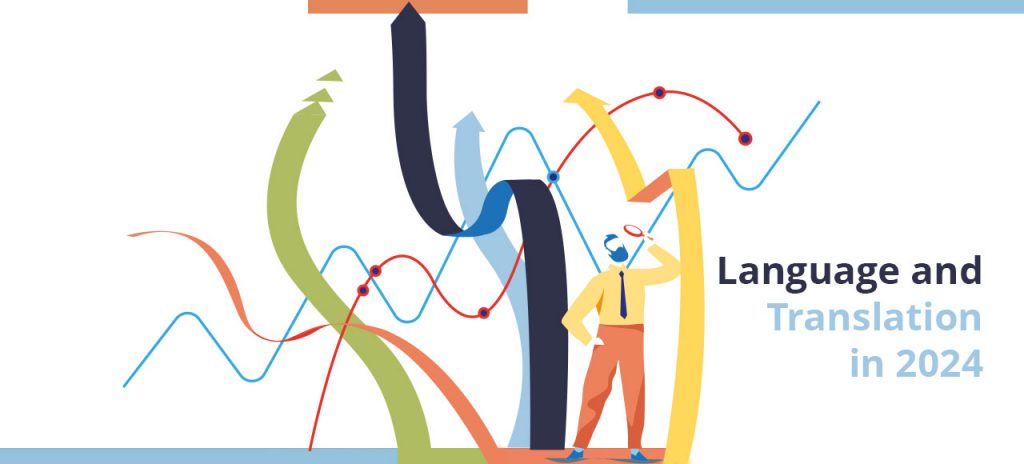5 predictions for the World of Languages this Year
It isn’t overstating things to say that without communication across languages, the world would be a very different place. Translators are one of the engines behind successful global collaboration and they play a significant role in helping us create the inter-connected, multicultural and exciting world we all share.
But while this gives the translation and localization industry the flexibility to work in all business sectors bringing resilience and longevity, it also means that global forces can have a significant effect on the work we do. 2023 was a year when these forces were fully felt.
Economic factors such as rising interest rates, high inflation and geopolitical pressures put a strain on costs and profit margins and growth was slowed sector wide. But it was undoubtedly the rise of generative artificial intelligence and the prospect of radical shifts to working practices, that has given the language industry a reason to prepare for more disruption in 2024.
1. Coming to terms with AI
The ripple effect of the generative AI transformation is only just beginning. No one could have predicted that when OpenAI released ChatGPT in November 2022 it would have such an immediate impact and we still don’t really know what the end result will be. 2024 then, is going to be a year when the language industry learns exactly what GenAI brings to the table
Over the last 12 months or so, the limitations of language-producing AI programs have become apparent and we now know much more about what these large language models (LLMs) can and cannot do. While they are useful language tools, they are still too prone to ‘hallucination’ to be trusted with texts where accuracy and precision are key. In 2024 it is likely that we’ll continue to discover how to make the best use of this technology and where it can offer the most benefits to our customers.
2. A renewed focus on people
There have been many voices over the past year predicting the demise of the human translator, interpreter or writer as artificial intelligence threatens to take over these creative language roles. Fortunately, these assertions are proving unfounded for the moment and it is now clear that humans have many skills the machines are yet to master.
Judging fairness and honesty, spotting bias and being sensitive to cultural nuance, are not abilities that belong to ChatGPT’s repertoire. LLMs can be inventive with the truth (‘hallucination’) and do not have the same powers of human sensitivity or common sense. They can make fluent and grammatically correct language but their texts risk being factually inaccurate and stylishly unimaginative.
In global industries like healthcare, finance and technology, inaccurate language isn’t an option and organizations now recognize that human translators are essential to their successful international operations. Rather than eliminating human intervention, the rise of AI could in fact, put more value on the unmatched skills of living and breathing experts.
3. Localization as a foundation for growth
Studies have consistently shown that when language is factored into a company’s expansion efforts and content is adapted linguistically and culturally to fit a target audience, the effects on buyer behaviour are almost always positive. With an increasingly interlinked, digitalized world, business can cross borders instantly and taking advantage of new markets now means prioritizing language and local adaptation.
Putting localization at the heart – and therefore, the beginning – of your company’s international expansion is a growing trend and one that more global businesses are implementing successfully. Dropping localization into the conversation at the earliest point possible across an organization helps language stay on the agenda and not get treated as an afterthought. With the globalization of business still on the upward trajectory, planning an agile and scalable multilingual strategy from day one looks likely to be at the forefront of many CEO’s minds this year.
4. Media translation still going strong
A quick look at your television streaming services tells you that watching movies and TV shows from around the world is now something most of us do without thinking twice about it. We’ve quickly become used to engrossing ourselves in stories from different cultures and in different languages, and the number of platforms that bring this content into our homes keeps growing.
This means that the demand to access content in other languages through subtitles, dubbing and voiceover has seen a significant rise in recent times and as with localization in general, planning which markets media content can travel to and which type of language access will work, are increasingly considerations from the outset.
AI is also infiltrating this sector with ASR (automatic speech recognition) and synthetic voice technologies developing quickly and causing organizations to look at where they could be suitable for use. Balanced with human guidance, these new technologies will undoubtedly help fulfil the rising demand for media translation. With the end of the Hollywood strikes, this sector of the language industry looks set to rebound in 2024 and see a year of high work volumes and technological development.
5. A demand for different languages
Shifting economies create the need for different languages globally and emerging markets in Asia, Africa and South America mean that languages like Hindi, Portuguese and Arabic are being used more widely, driven by factors like population growth and the spread of e-commerce. 2024 will most likely see the ever-nimble translation industry continue to refocus on these in-demand languages, adapting human and tech resources as a consequence.
The UN’s Decade of Indigenous Languages is helping to spread awareness of the imminent danger of disappearance that thousands of languages face and the importance of language revitalization. Many projects across the world are working to both preserve minority languages and encourage their use and the recognition of the cultural, historical and ecological relevance of all human language is driving the campaign to include more of these languages in the digital landscape. As 2024 takes shape, ensuring that everyone can access the internet, essential services and education in their native language will hopefully continue to be a theme of the year.
A year to be optimistic
Language is something that unites us all in our humanity. Understanding that people are the most skilled creators, speakers and users of language and that it is us who make connections and not machines, is perhaps one thing we will all embrace more fully in 2024. While technology provides amazing support for many jobs in the language sector, people are its beating heart.
Here’s to a human-powered, human-positive and technology-assisted 2024.

